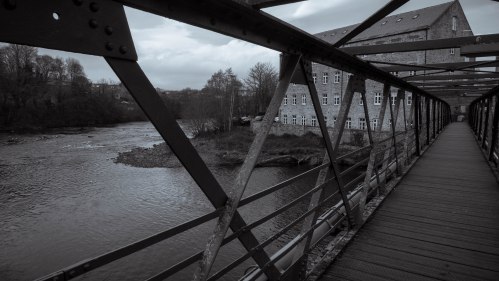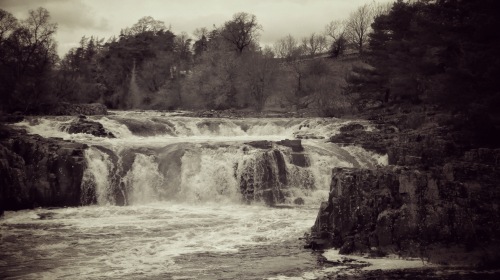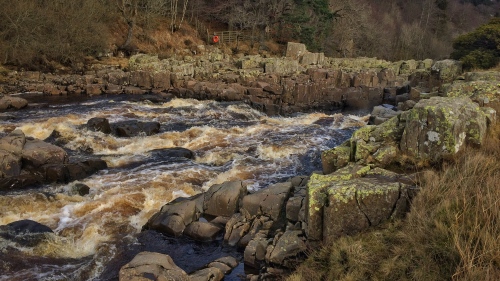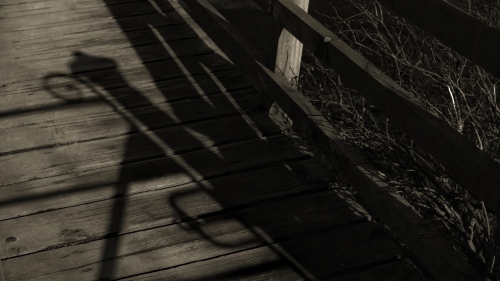I always knew this was going to be a longtime series, but it seems it was May 2017 when I last posted something on this project.
Quick recap: I’m visiting all the crossings over the River Tees in North East* England, from source to sea. I’m interested in the role of the river in the landscape generally but also how people have sought to get from one side to the other and why. It’s a long and fascinating history of people in their landscape, and I don’t think there’s another river with such variety and heritage as the Tees. Also, it’s where I live. So far I’ve done five of them – four bridges and a dam wall and they’ve all been in order. I’ve since visited another three with the intention of posting about them, but for some reason I hadn’t actually done so. I’ll probably go back and revisit these before posting them to refresh my memory.
So, being that quiet time between Christmas and New Year, and armed with a new pair of walking boots, I decided to explore another couple of bridges on the route. To confuse things a little, they’re further downstream than I’d got up to. And I did them in reverse order. But it’s two more off the list..
I live in Upper Teesdale – where the river is wild and the centre of the landscape as the fells all roll down to the river at the bottom of this long and narrow valley. It’s very rural and very remote – there are no shops and even the nearest pub is a good couple of miles away across the fields. So to get anything I generally have to drive a fair way.
Barnard Castle is not a place I really know that well. It’s the nearest market town, but it’s not that big. I only ever go to Barnard Castle because I have to, not because I want to. It’s not far enough to be exotic or a day trip, and not big enough to be the solution for all the complicated things I need that I can’t get locally, so I really don’t go there that often. So the bridges of the Tees seemed a good excuse to go and discover bits of the town I didn’t know.

I started at the Bowes Museum – one of the few reasons I go to the town, and mostly because of work, but as local museums and art galleries go, it really does take some beating and I know I’m really lucky to have such a place on my doorstep.
A short stroll across the road between the old vicarage and another large victorian country house you find yourself in the open fields of the Demesnes. These were the fields owned by the lord of the castle for his own use rather than tenanted farmers. They’re now an open space for the use of the people of the town. The well trodden footpath leads down behind the waterworks to the river. Here the river is wide and shallow and skips over small rocks scattered across its width. The route of the river is through a shallow gorge with occasional bare rock cliff faces. Very quickly you are out of the town and into open countryside and it’s all very tranquil.



Soon you get a first glimpse of the ruins of Egglestone Abbey on the other side of the river. Here the river gets rockier and more turbulent as it narrows. There are the remains of the Abbey Mill footing into the water on the far side. A short wooded slope brings you up to the top of Abbey Bridge.

The steep woods around the bridge make it hard to get a good look at the single stone arch itself, but being the middle of winter, it’s also the time for seeing glimpses through the bare foliage.

The bridge itself is a sturdy affair – it’s the diversionary route for vehicles too heavy for Barnard Castle bridge and Whorlton Bridge either side and has the battle scars of the wagons too big for the sharp turn onto it as a result.
The bridge was built in 1773 by the Morrits of nearby Rokeby (yes, that Rokeby – Turner, Walter Scott etc.) who wanetd better access from their estate to Barnard Castle. A single track crossing, it has distinctive castellated parapets and refuges above the arch pillars. On the south side are two octagonal enclosures – the remains of the toll booths in use up until the 1950s.

It’s a very high bridge with good views of the river from the top as it passes in a rocky and turbulent gorge beneath.

Crossing the bridge, I turned back on the other side, past the impressive 12th Century ruins of Egglestone Abbey up on its rocky vantage point. Beneath the foot of the abbey the road crosses a small beck beside the river. This was originally a ford and the 17th century packhorse bridge sits beside it. Still in great condition, but too steep and narrow for cars.

The footpath leaves the road when it deviates away from the river and crosses a handful of fields above the wooded gorge. Again, the leafless trees giving glimpses of the landscape beyond.

The trail passes through a caravan park on the banks of the river. There’s something quite surreal about these places – like an out of place suburbia existing in its own well ordered world. The footpath quickly reaches the outskirts of the town and the mill buildings along the rivers edge to the north.

Thorngate Bridge is a long, green iron girder bridge spanning the shallow and wide river on the exit of a sharp bend. Built in 1881, the bridge replaced a lightweight three span bridge on the site that was washed away within 10 years. Before that the shallow river was crossed at this point by stepping stones.

Thorngate Bridge is in three spans on two short pillars. The main span in the centre being over 50m long. The bridge remains largely unaltered from the day it was built – a very utilitarian footbridge made from steel and cast iron girders with a wooden walkway. The lamp brackets at either end are now empty and were the only source of illumination. The bridge was built to enable workers from the Yorkshire side of the river to get to work in the 19thC mill on the north bank.

The wool industry was a major part of the town of Barnard Castle. Beyond the Victorian carpet mills down by the river, the short walk back up Thorngate passes some of the most fascinating 17th and 18th C houses with their weaving loft windows up on the top floors.

It’s been interesting to explore somewhere I kind of know but don’t really know. There’s another 4 crossings around the town which I’m looking forward to discovering and getting more familiar with. Barnard Castle is also the outer limit to what I consider to be ‘local’. Beyond the town the landscape is very different and the route goes to places that are mostly new to me. Hopefully it won’t be another another 18 months before I do more exploring.
*technically the river Tees starts in Cumbria which is technically in the North West, but borders are a bit vague here…























